Strategic Analysis Report on Amazon's Business Development
VerifiedAdded on 2023/06/18
|17
|4864
|303
Report
AI Summary
This strategic analysis report assesses Amazon's corporate strategy, utilizing PESTEL analysis to understand macro factors and Porter's Five Forces to evaluate industry effectiveness. The internal analysis employs value chain and VRIO frameworks to identify key resources and competences. Th...
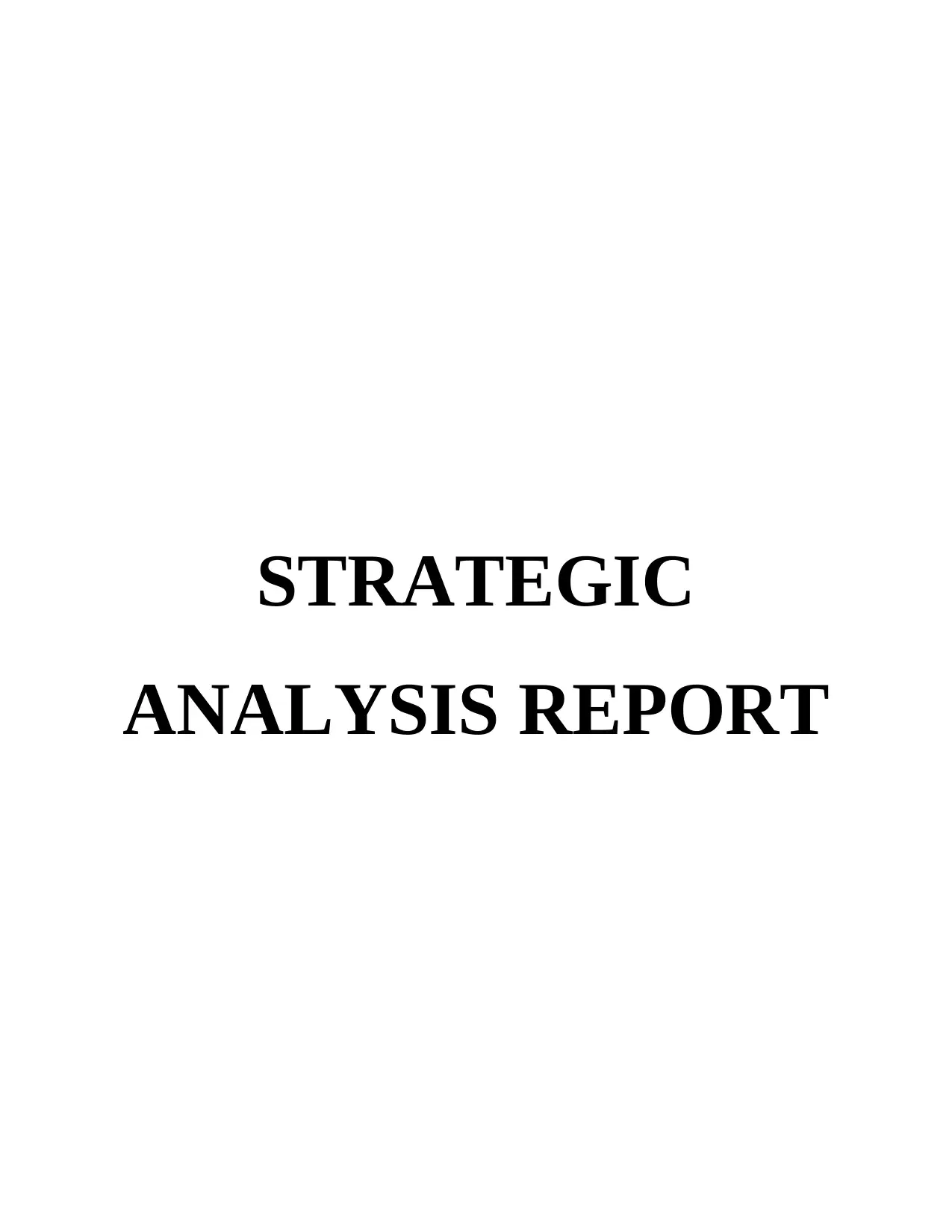
STRATEGIC
ANALYSIS REPORT
ANALYSIS REPORT
Paraphrase This Document
Need a fresh take? Get an instant paraphrase of this document with our AI Paraphraser

Table of Contents
INTRODUCTION...........................................................................................................................3
Amazon’s Background.................................................................................................................3
EXTERNAL ANALYSIS................................................................................................................3
PESTEL ANALYSIS..................................................................................................................3
PORTER FIVE FORCES............................................................................................................5
INTERNAL ANALYSIS.................................................................................................................7
RESOURCES..............................................................................................................................7
COMPETENCES.........................................................................................................................7
STRATEGY EVALUATION........................................................................................................10
SUITABILITY...........................................................................................................................11
ACCEPTABILITY....................................................................................................................12
FEASIBILITY...........................................................................................................................12
CONCLUSION..............................................................................................................................13
SUMMARY...................................................................................................................................13
REFLECTIVE ACCOUNT ..........................................................................................................14
REFERENCES..............................................................................................................................16
INTRODUCTION...........................................................................................................................3
Amazon’s Background.................................................................................................................3
EXTERNAL ANALYSIS................................................................................................................3
PESTEL ANALYSIS..................................................................................................................3
PORTER FIVE FORCES............................................................................................................5
INTERNAL ANALYSIS.................................................................................................................7
RESOURCES..............................................................................................................................7
COMPETENCES.........................................................................................................................7
STRATEGY EVALUATION........................................................................................................10
SUITABILITY...........................................................................................................................11
ACCEPTABILITY....................................................................................................................12
FEASIBILITY...........................................................................................................................12
CONCLUSION..............................................................................................................................13
SUMMARY...................................................................................................................................13
REFLECTIVE ACCOUNT ..........................................................................................................14
REFERENCES..............................................................................................................................16

INTRODUCTION
This project report will assess corporate strategy of Amazon. The external factors will be
identified with the help of Pestel analysis for understanding macro factors and Porter five forces
framework will be applied for understanding industry effectiveness. The report will also identify
internal factors with the help of value chain and VRIO framework. Lastly, the report will define
the SAFe technique which will be implemented in order to identify the viability.
Amazon’s Background
Amazon is an American multinational technology company which is operating in cloud
computing, e-commerce, artificial intelligence, consumer electronics, entertainment, digital
distribution, self-driving cars and retail industry. The company was founded by Jeff Bezos in the
year 1994 and is currently operating worldwide. The company is operating as world's largest
online marketplace and offers a wide variety of products and services that can be availed by
customers.
EXTERNAL ANALYSIS
PESTEL ANALYSIS
Political factor (threat)- Political factors for E-Commerce business and technological
industry can create a threats, as there are various giant companies which are already operating in
the industry such as eBay and Amazon (Abushova, Burova and Suloeva, 2016). The political
factors such as political and regulatory factors create an incline in the challenge which will be
faced by e-commerce business. As the growth rate of e-commerce in Europe is low, this has been
a threat for companies operating in the same industry. Political stability in different regions of
the world derived economic stability whereas, political issues create a challenge for E-
Commerce business to effectively and smoothly operate in the industry. Political issues have led
to disruption of business at online and physical level and influenced the growth of e-commerce
business which majorly acted as a threat for companies.
Economic factor (opportunity)- Economic factors create huge impact on the term of
business and such factors directly linked with business which influence the revenues and profits
of companies operating in e-commerce industry (Balasubramanian, Bhattacharya and Krishnan,
2015). Due to economic recession, this has affected and lead to fluctuation in economic stability
This project report will assess corporate strategy of Amazon. The external factors will be
identified with the help of Pestel analysis for understanding macro factors and Porter five forces
framework will be applied for understanding industry effectiveness. The report will also identify
internal factors with the help of value chain and VRIO framework. Lastly, the report will define
the SAFe technique which will be implemented in order to identify the viability.
Amazon’s Background
Amazon is an American multinational technology company which is operating in cloud
computing, e-commerce, artificial intelligence, consumer electronics, entertainment, digital
distribution, self-driving cars and retail industry. The company was founded by Jeff Bezos in the
year 1994 and is currently operating worldwide. The company is operating as world's largest
online marketplace and offers a wide variety of products and services that can be availed by
customers.
EXTERNAL ANALYSIS
PESTEL ANALYSIS
Political factor (threat)- Political factors for E-Commerce business and technological
industry can create a threats, as there are various giant companies which are already operating in
the industry such as eBay and Amazon (Abushova, Burova and Suloeva, 2016). The political
factors such as political and regulatory factors create an incline in the challenge which will be
faced by e-commerce business. As the growth rate of e-commerce in Europe is low, this has been
a threat for companies operating in the same industry. Political stability in different regions of
the world derived economic stability whereas, political issues create a challenge for E-
Commerce business to effectively and smoothly operate in the industry. Political issues have led
to disruption of business at online and physical level and influenced the growth of e-commerce
business which majorly acted as a threat for companies.
Economic factor (opportunity)- Economic factors create huge impact on the term of
business and such factors directly linked with business which influence the revenues and profits
of companies operating in e-commerce industry (Balasubramanian, Bhattacharya and Krishnan,
2015). Due to economic recession, this has affected and lead to fluctuation in economic stability
⊘ This is a preview!⊘
Do you want full access?
Subscribe today to unlock all pages.

Trusted by 1+ million students worldwide
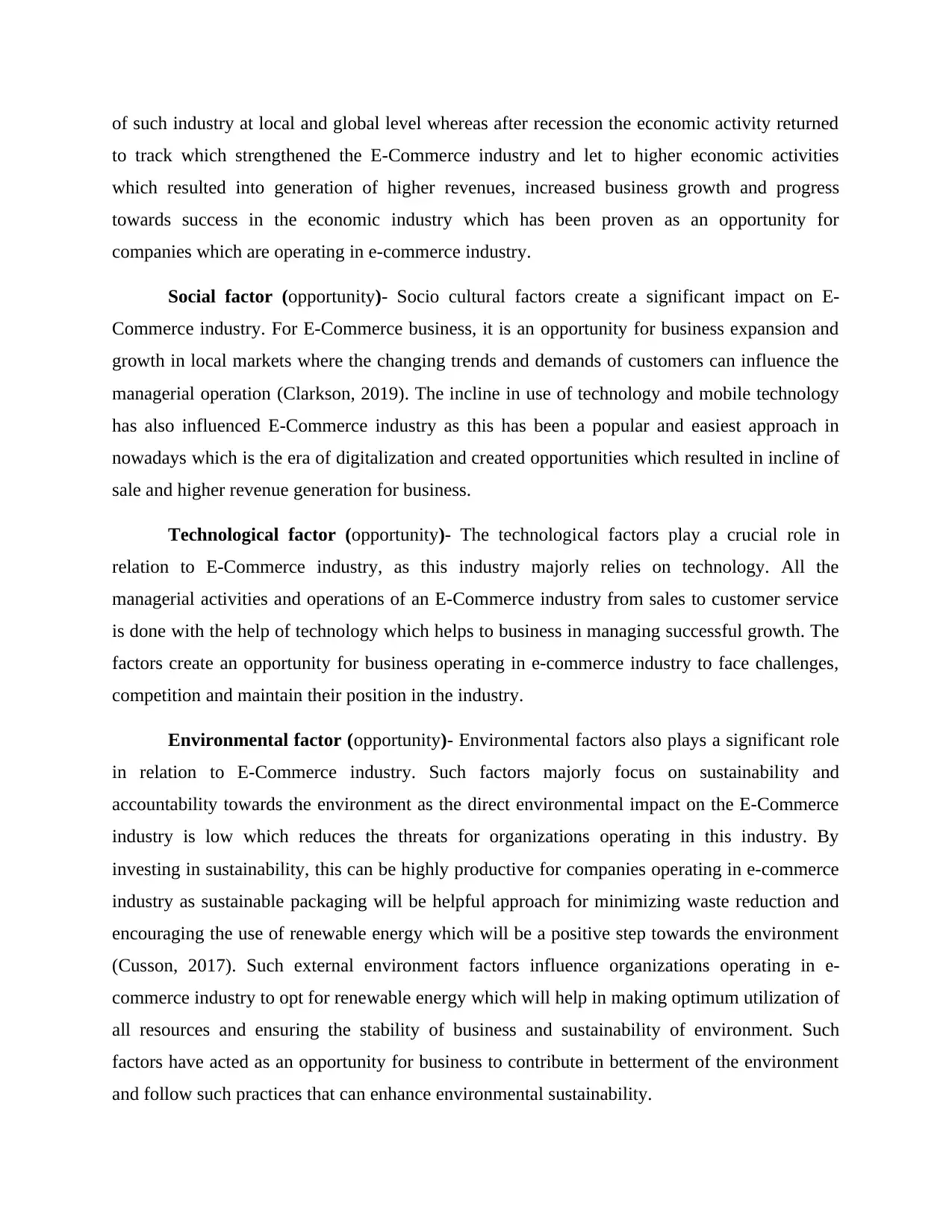
of such industry at local and global level whereas after recession the economic activity returned
to track which strengthened the E-Commerce industry and let to higher economic activities
which resulted into generation of higher revenues, increased business growth and progress
towards success in the economic industry which has been proven as an opportunity for
companies which are operating in e-commerce industry.
Social factor (opportunity)- Socio cultural factors create a significant impact on E-
Commerce industry. For E-Commerce business, it is an opportunity for business expansion and
growth in local markets where the changing trends and demands of customers can influence the
managerial operation (Clarkson, 2019). The incline in use of technology and mobile technology
has also influenced E-Commerce industry as this has been a popular and easiest approach in
nowadays which is the era of digitalization and created opportunities which resulted in incline of
sale and higher revenue generation for business.
Technological factor (opportunity)- The technological factors play a crucial role in
relation to E-Commerce industry, as this industry majorly relies on technology. All the
managerial activities and operations of an E-Commerce industry from sales to customer service
is done with the help of technology which helps to business in managing successful growth. The
factors create an opportunity for business operating in e-commerce industry to face challenges,
competition and maintain their position in the industry.
Environmental factor (opportunity)- Environmental factors also plays a significant role
in relation to E-Commerce industry. Such factors majorly focus on sustainability and
accountability towards the environment as the direct environmental impact on the E-Commerce
industry is low which reduces the threats for organizations operating in this industry. By
investing in sustainability, this can be highly productive for companies operating in e-commerce
industry as sustainable packaging will be helpful approach for minimizing waste reduction and
encouraging the use of renewable energy which will be a positive step towards the environment
(Cusson, 2017). Such external environment factors influence organizations operating in e-
commerce industry to opt for renewable energy which will help in making optimum utilization of
all resources and ensuring the stability of business and sustainability of environment. Such
factors have acted as an opportunity for business to contribute in betterment of the environment
and follow such practices that can enhance environmental sustainability.
to track which strengthened the E-Commerce industry and let to higher economic activities
which resulted into generation of higher revenues, increased business growth and progress
towards success in the economic industry which has been proven as an opportunity for
companies which are operating in e-commerce industry.
Social factor (opportunity)- Socio cultural factors create a significant impact on E-
Commerce industry. For E-Commerce business, it is an opportunity for business expansion and
growth in local markets where the changing trends and demands of customers can influence the
managerial operation (Clarkson, 2019). The incline in use of technology and mobile technology
has also influenced E-Commerce industry as this has been a popular and easiest approach in
nowadays which is the era of digitalization and created opportunities which resulted in incline of
sale and higher revenue generation for business.
Technological factor (opportunity)- The technological factors play a crucial role in
relation to E-Commerce industry, as this industry majorly relies on technology. All the
managerial activities and operations of an E-Commerce industry from sales to customer service
is done with the help of technology which helps to business in managing successful growth. The
factors create an opportunity for business operating in e-commerce industry to face challenges,
competition and maintain their position in the industry.
Environmental factor (opportunity)- Environmental factors also plays a significant role
in relation to E-Commerce industry. Such factors majorly focus on sustainability and
accountability towards the environment as the direct environmental impact on the E-Commerce
industry is low which reduces the threats for organizations operating in this industry. By
investing in sustainability, this can be highly productive for companies operating in e-commerce
industry as sustainable packaging will be helpful approach for minimizing waste reduction and
encouraging the use of renewable energy which will be a positive step towards the environment
(Cusson, 2017). Such external environment factors influence organizations operating in e-
commerce industry to opt for renewable energy which will help in making optimum utilization of
all resources and ensuring the stability of business and sustainability of environment. Such
factors have acted as an opportunity for business to contribute in betterment of the environment
and follow such practices that can enhance environmental sustainability.
Paraphrase This Document
Need a fresh take? Get an instant paraphrase of this document with our AI Paraphraser
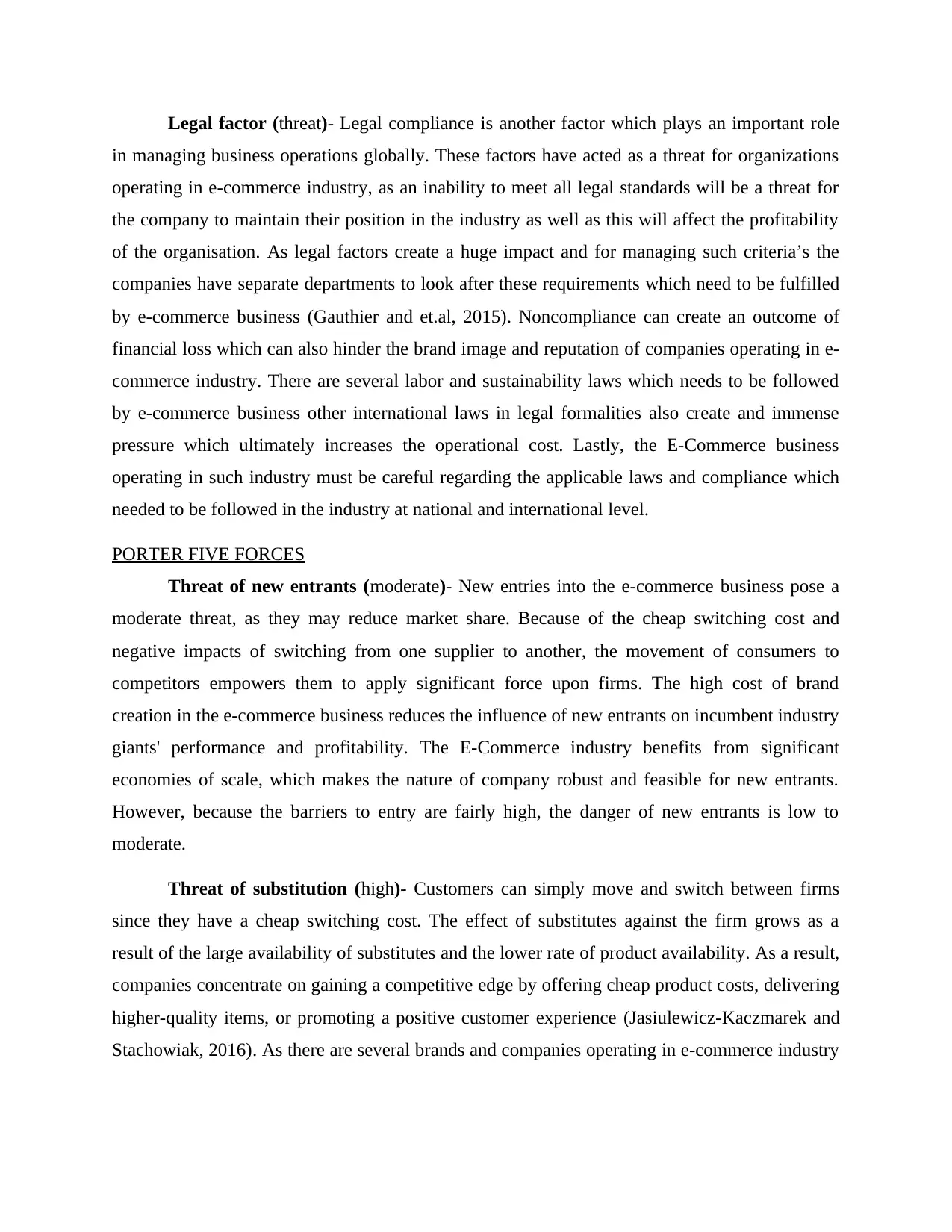
Legal factor (threat)- Legal compliance is another factor which plays an important role
in managing business operations globally. These factors have acted as a threat for organizations
operating in e-commerce industry, as an inability to meet all legal standards will be a threat for
the company to maintain their position in the industry as well as this will affect the profitability
of the organisation. As legal factors create a huge impact and for managing such criteria’s the
companies have separate departments to look after these requirements which need to be fulfilled
by e-commerce business (Gauthier and et.al, 2015). Noncompliance can create an outcome of
financial loss which can also hinder the brand image and reputation of companies operating in e-
commerce industry. There are several labor and sustainability laws which needs to be followed
by e-commerce business other international laws in legal formalities also create and immense
pressure which ultimately increases the operational cost. Lastly, the E-Commerce business
operating in such industry must be careful regarding the applicable laws and compliance which
needed to be followed in the industry at national and international level.
PORTER FIVE FORCES
Threat of new entrants (moderate)- New entries into the e-commerce business pose a
moderate threat, as they may reduce market share. Because of the cheap switching cost and
negative impacts of switching from one supplier to another, the movement of consumers to
competitors empowers them to apply significant force upon firms. The high cost of brand
creation in the e-commerce business reduces the influence of new entrants on incumbent industry
giants' performance and profitability. The E-Commerce industry benefits from significant
economies of scale, which makes the nature of company robust and feasible for new entrants.
However, because the barriers to entry are fairly high, the danger of new entrants is low to
moderate.
Threat of substitution (high)- Customers can simply move and switch between firms
since they have a cheap switching cost. The effect of substitutes against the firm grows as a
result of the large availability of substitutes and the lower rate of product availability. As a result,
companies concentrate on gaining a competitive edge by offering cheap product costs, delivering
higher-quality items, or promoting a positive customer experience (Jasiulewicz-Kaczmarek and
Stachowiak, 2016). As there are several brands and companies operating in e-commerce industry
in managing business operations globally. These factors have acted as a threat for organizations
operating in e-commerce industry, as an inability to meet all legal standards will be a threat for
the company to maintain their position in the industry as well as this will affect the profitability
of the organisation. As legal factors create a huge impact and for managing such criteria’s the
companies have separate departments to look after these requirements which need to be fulfilled
by e-commerce business (Gauthier and et.al, 2015). Noncompliance can create an outcome of
financial loss which can also hinder the brand image and reputation of companies operating in e-
commerce industry. There are several labor and sustainability laws which needs to be followed
by e-commerce business other international laws in legal formalities also create and immense
pressure which ultimately increases the operational cost. Lastly, the E-Commerce business
operating in such industry must be careful regarding the applicable laws and compliance which
needed to be followed in the industry at national and international level.
PORTER FIVE FORCES
Threat of new entrants (moderate)- New entries into the e-commerce business pose a
moderate threat, as they may reduce market share. Because of the cheap switching cost and
negative impacts of switching from one supplier to another, the movement of consumers to
competitors empowers them to apply significant force upon firms. The high cost of brand
creation in the e-commerce business reduces the influence of new entrants on incumbent industry
giants' performance and profitability. The E-Commerce industry benefits from significant
economies of scale, which makes the nature of company robust and feasible for new entrants.
However, because the barriers to entry are fairly high, the danger of new entrants is low to
moderate.
Threat of substitution (high)- Customers can simply move and switch between firms
since they have a cheap switching cost. The effect of substitutes against the firm grows as a
result of the large availability of substitutes and the lower rate of product availability. As a result,
companies concentrate on gaining a competitive edge by offering cheap product costs, delivering
higher-quality items, or promoting a positive customer experience (Jasiulewicz-Kaczmarek and
Stachowiak, 2016). As there are several brands and companies operating in e-commerce industry
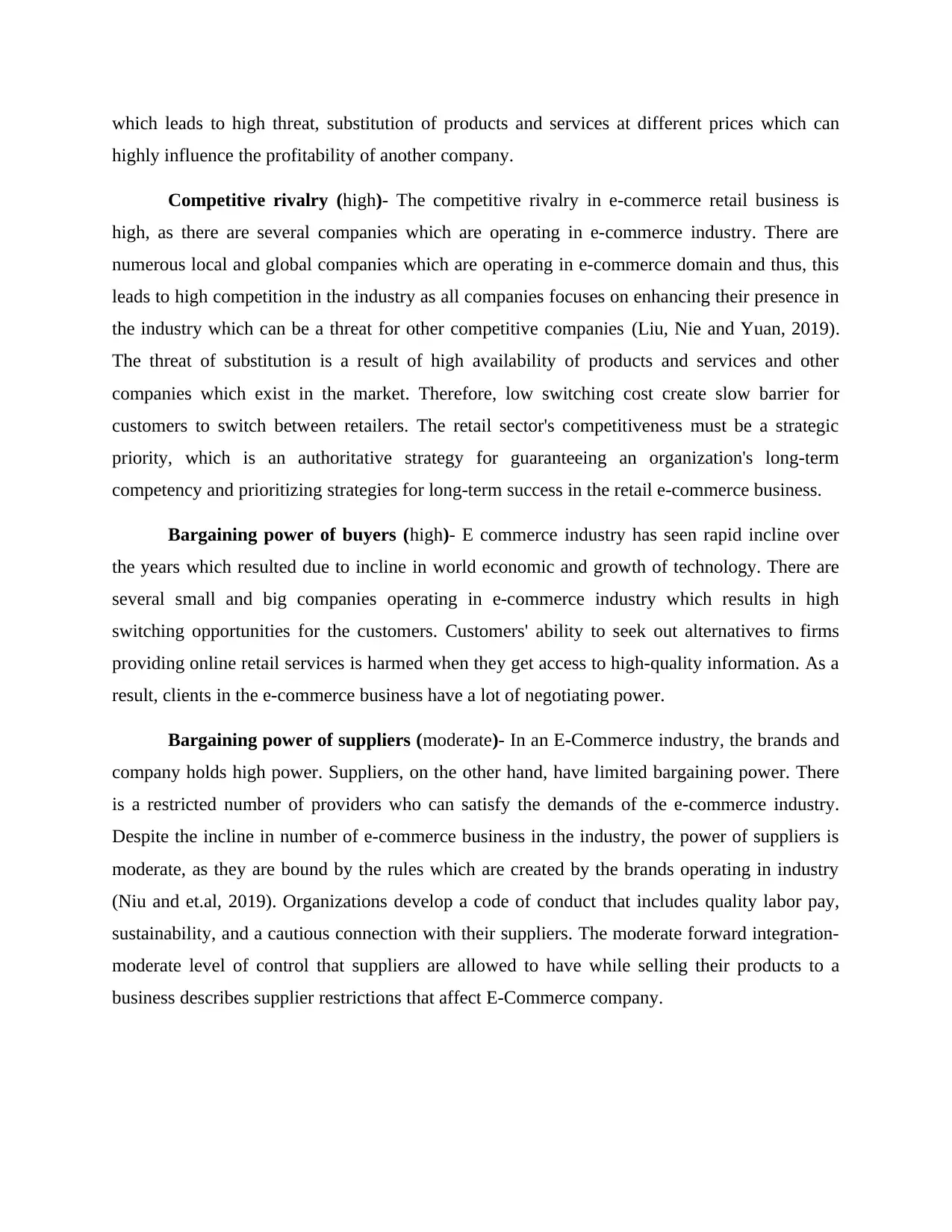
which leads to high threat, substitution of products and services at different prices which can
highly influence the profitability of another company.
Competitive rivalry (high)- The competitive rivalry in e-commerce retail business is
high, as there are several companies which are operating in e-commerce industry. There are
numerous local and global companies which are operating in e-commerce domain and thus, this
leads to high competition in the industry as all companies focuses on enhancing their presence in
the industry which can be a threat for other competitive companies (Liu, Nie and Yuan, 2019).
The threat of substitution is a result of high availability of products and services and other
companies which exist in the market. Therefore, low switching cost create slow barrier for
customers to switch between retailers. The retail sector's competitiveness must be a strategic
priority, which is an authoritative strategy for guaranteeing an organization's long-term
competency and prioritizing strategies for long-term success in the retail e-commerce business.
Bargaining power of buyers (high)- E commerce industry has seen rapid incline over
the years which resulted due to incline in world economic and growth of technology. There are
several small and big companies operating in e-commerce industry which results in high
switching opportunities for the customers. Customers' ability to seek out alternatives to firms
providing online retail services is harmed when they get access to high-quality information. As a
result, clients in the e-commerce business have a lot of negotiating power.
Bargaining power of suppliers (moderate)- In an E-Commerce industry, the brands and
company holds high power. Suppliers, on the other hand, have limited bargaining power. There
is a restricted number of providers who can satisfy the demands of the e-commerce industry.
Despite the incline in number of e-commerce business in the industry, the power of suppliers is
moderate, as they are bound by the rules which are created by the brands operating in industry
(Niu and et.al, 2019). Organizations develop a code of conduct that includes quality labor pay,
sustainability, and a cautious connection with their suppliers. The moderate forward integration-
moderate level of control that suppliers are allowed to have while selling their products to a
business describes supplier restrictions that affect E-Commerce company.
highly influence the profitability of another company.
Competitive rivalry (high)- The competitive rivalry in e-commerce retail business is
high, as there are several companies which are operating in e-commerce industry. There are
numerous local and global companies which are operating in e-commerce domain and thus, this
leads to high competition in the industry as all companies focuses on enhancing their presence in
the industry which can be a threat for other competitive companies (Liu, Nie and Yuan, 2019).
The threat of substitution is a result of high availability of products and services and other
companies which exist in the market. Therefore, low switching cost create slow barrier for
customers to switch between retailers. The retail sector's competitiveness must be a strategic
priority, which is an authoritative strategy for guaranteeing an organization's long-term
competency and prioritizing strategies for long-term success in the retail e-commerce business.
Bargaining power of buyers (high)- E commerce industry has seen rapid incline over
the years which resulted due to incline in world economic and growth of technology. There are
several small and big companies operating in e-commerce industry which results in high
switching opportunities for the customers. Customers' ability to seek out alternatives to firms
providing online retail services is harmed when they get access to high-quality information. As a
result, clients in the e-commerce business have a lot of negotiating power.
Bargaining power of suppliers (moderate)- In an E-Commerce industry, the brands and
company holds high power. Suppliers, on the other hand, have limited bargaining power. There
is a restricted number of providers who can satisfy the demands of the e-commerce industry.
Despite the incline in number of e-commerce business in the industry, the power of suppliers is
moderate, as they are bound by the rules which are created by the brands operating in industry
(Niu and et.al, 2019). Organizations develop a code of conduct that includes quality labor pay,
sustainability, and a cautious connection with their suppliers. The moderate forward integration-
moderate level of control that suppliers are allowed to have while selling their products to a
business describes supplier restrictions that affect E-Commerce company.
⊘ This is a preview!⊘
Do you want full access?
Subscribe today to unlock all pages.

Trusted by 1+ million students worldwide
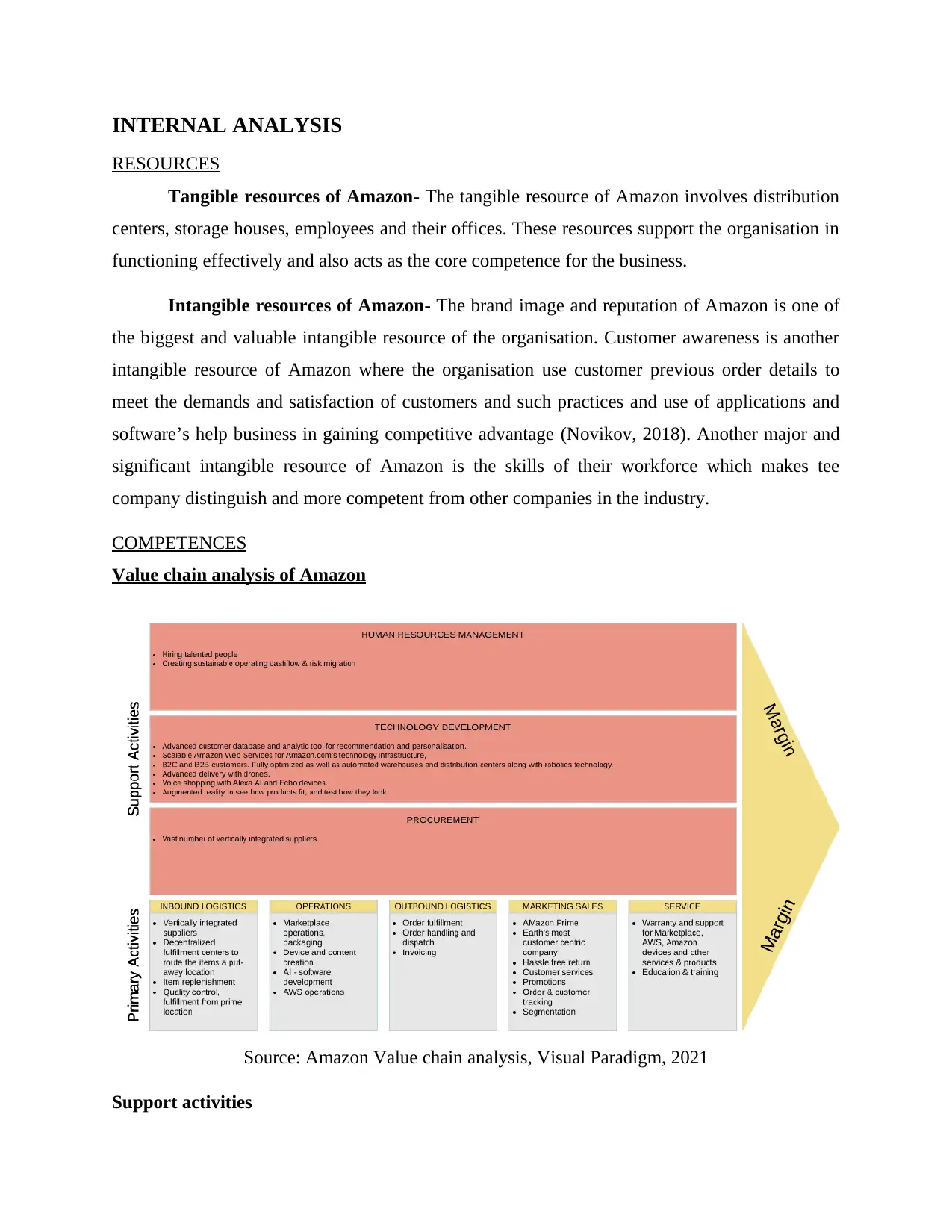
INTERNAL ANALYSIS
RESOURCES
Tangible resources of Amazon- The tangible resource of Amazon involves distribution
centers, storage houses, employees and their offices. These resources support the organisation in
functioning effectively and also acts as the core competence for the business.
Intangible resources of Amazon- The brand image and reputation of Amazon is one of
the biggest and valuable intangible resource of the organisation. Customer awareness is another
intangible resource of Amazon where the organisation use customer previous order details to
meet the demands and satisfaction of customers and such practices and use of applications and
software’s help business in gaining competitive advantage (Novikov, 2018). Another major and
significant intangible resource of Amazon is the skills of their workforce which makes tee
company distinguish and more competent from other companies in the industry.
COMPETENCES
Value chain analysis of Amazon
Source: Amazon Value chain analysis, Visual Paradigm, 2021
Support activities
RESOURCES
Tangible resources of Amazon- The tangible resource of Amazon involves distribution
centers, storage houses, employees and their offices. These resources support the organisation in
functioning effectively and also acts as the core competence for the business.
Intangible resources of Amazon- The brand image and reputation of Amazon is one of
the biggest and valuable intangible resource of the organisation. Customer awareness is another
intangible resource of Amazon where the organisation use customer previous order details to
meet the demands and satisfaction of customers and such practices and use of applications and
software’s help business in gaining competitive advantage (Novikov, 2018). Another major and
significant intangible resource of Amazon is the skills of their workforce which makes tee
company distinguish and more competent from other companies in the industry.
COMPETENCES
Value chain analysis of Amazon
Source: Amazon Value chain analysis, Visual Paradigm, 2021
Support activities
Paraphrase This Document
Need a fresh take? Get an instant paraphrase of this document with our AI Paraphraser
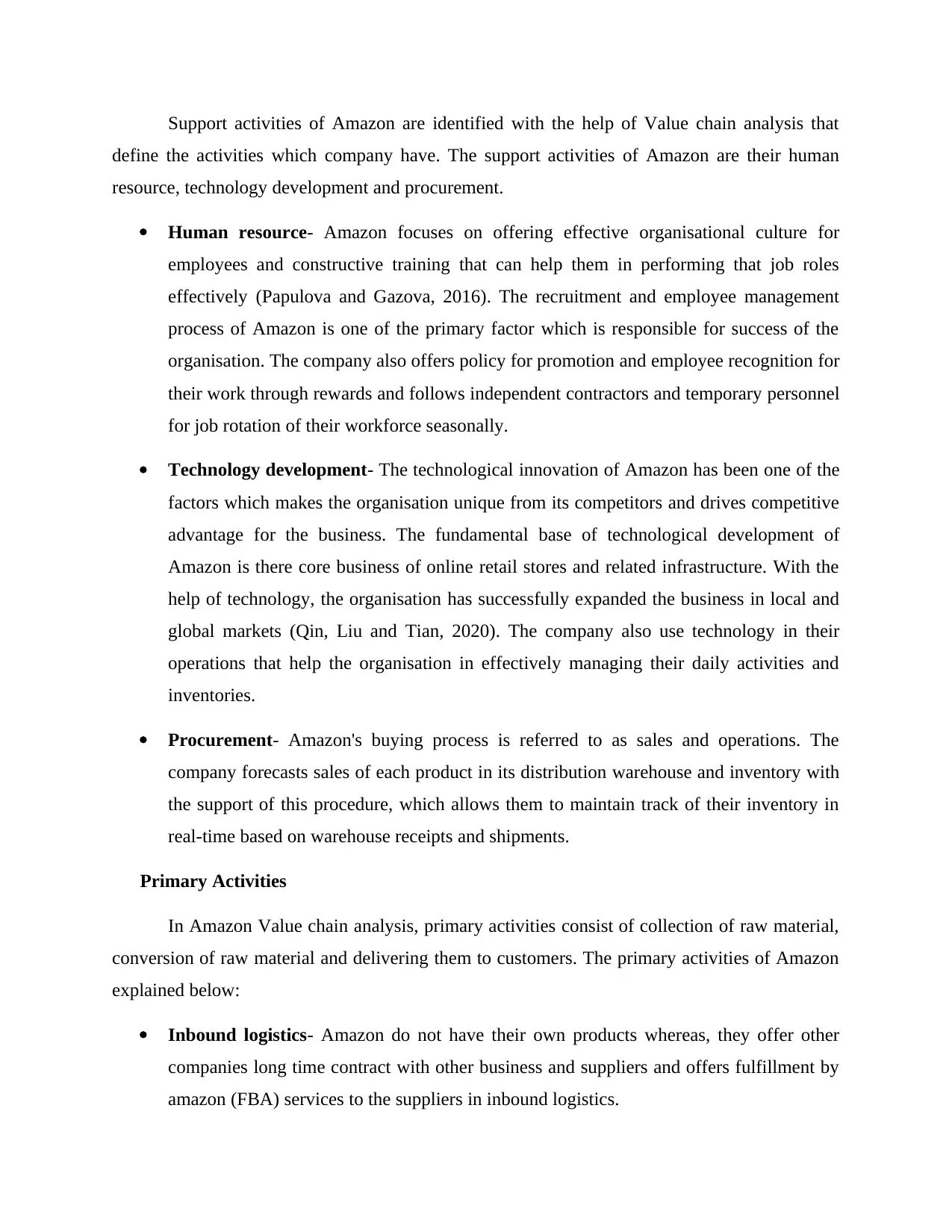
Support activities of Amazon are identified with the help of Value chain analysis that
define the activities which company have. The support activities of Amazon are their human
resource, technology development and procurement.
Human resource- Amazon focuses on offering effective organisational culture for
employees and constructive training that can help them in performing that job roles
effectively (Papulova and Gazova, 2016). The recruitment and employee management
process of Amazon is one of the primary factor which is responsible for success of the
organisation. The company also offers policy for promotion and employee recognition for
their work through rewards and follows independent contractors and temporary personnel
for job rotation of their workforce seasonally.
Technology development- The technological innovation of Amazon has been one of the
factors which makes the organisation unique from its competitors and drives competitive
advantage for the business. The fundamental base of technological development of
Amazon is there core business of online retail stores and related infrastructure. With the
help of technology, the organisation has successfully expanded the business in local and
global markets (Qin, Liu and Tian, 2020). The company also use technology in their
operations that help the organisation in effectively managing their daily activities and
inventories.
Procurement- Amazon's buying process is referred to as sales and operations. The
company forecasts sales of each product in its distribution warehouse and inventory with
the support of this procedure, which allows them to maintain track of their inventory in
real-time based on warehouse receipts and shipments.
Primary Activities
In Amazon Value chain analysis, primary activities consist of collection of raw material,
conversion of raw material and delivering them to customers. The primary activities of Amazon
explained below:
Inbound logistics- Amazon do not have their own products whereas, they offer other
companies long time contract with other business and suppliers and offers fulfillment by
amazon (FBA) services to the suppliers in inbound logistics.
define the activities which company have. The support activities of Amazon are their human
resource, technology development and procurement.
Human resource- Amazon focuses on offering effective organisational culture for
employees and constructive training that can help them in performing that job roles
effectively (Papulova and Gazova, 2016). The recruitment and employee management
process of Amazon is one of the primary factor which is responsible for success of the
organisation. The company also offers policy for promotion and employee recognition for
their work through rewards and follows independent contractors and temporary personnel
for job rotation of their workforce seasonally.
Technology development- The technological innovation of Amazon has been one of the
factors which makes the organisation unique from its competitors and drives competitive
advantage for the business. The fundamental base of technological development of
Amazon is there core business of online retail stores and related infrastructure. With the
help of technology, the organisation has successfully expanded the business in local and
global markets (Qin, Liu and Tian, 2020). The company also use technology in their
operations that help the organisation in effectively managing their daily activities and
inventories.
Procurement- Amazon's buying process is referred to as sales and operations. The
company forecasts sales of each product in its distribution warehouse and inventory with
the support of this procedure, which allows them to maintain track of their inventory in
real-time based on warehouse receipts and shipments.
Primary Activities
In Amazon Value chain analysis, primary activities consist of collection of raw material,
conversion of raw material and delivering them to customers. The primary activities of Amazon
explained below:
Inbound logistics- Amazon do not have their own products whereas, they offer other
companies long time contract with other business and suppliers and offers fulfillment by
amazon (FBA) services to the suppliers in inbound logistics.
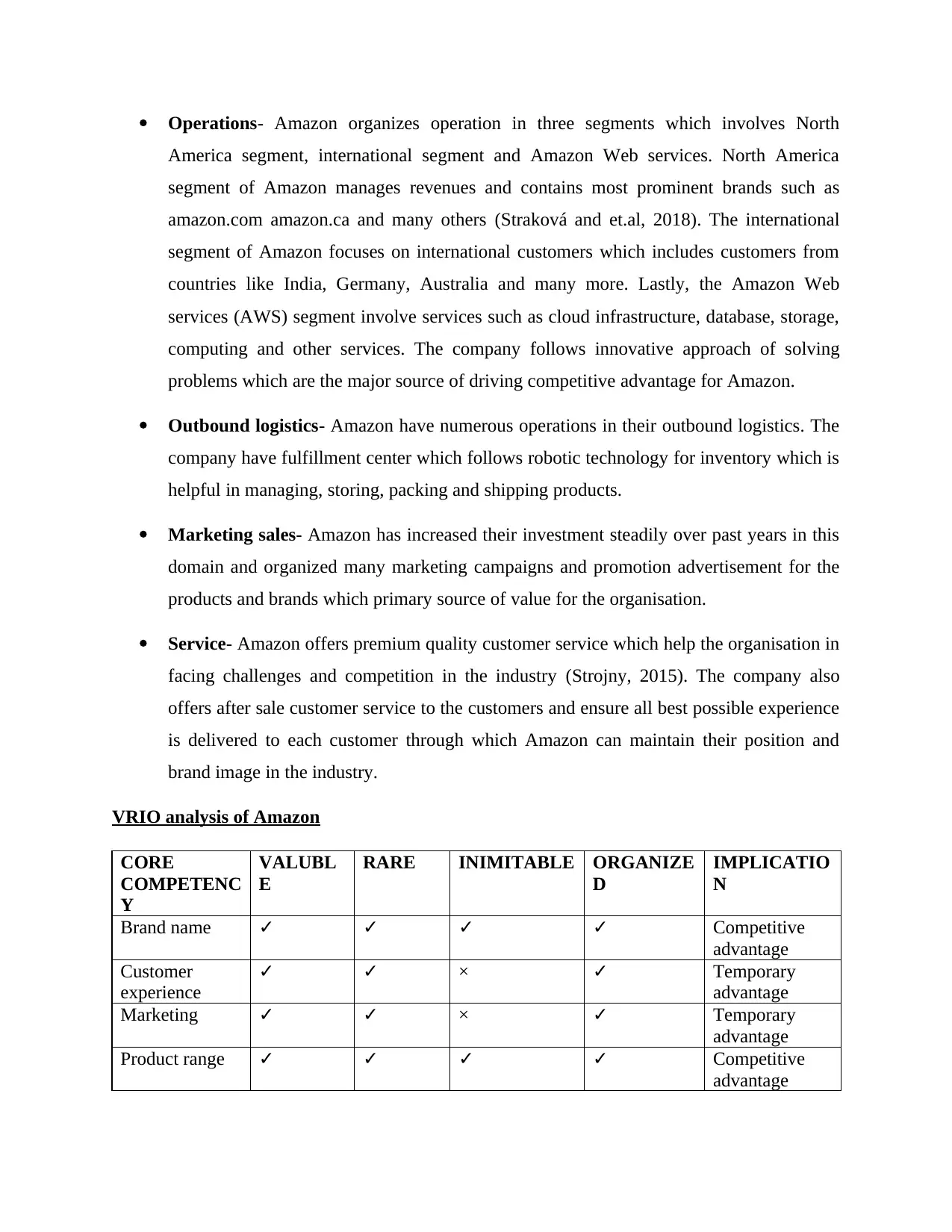
Operations- Amazon organizes operation in three segments which involves North
America segment, international segment and Amazon Web services. North America
segment of Amazon manages revenues and contains most prominent brands such as
amazon.com amazon.ca and many others (Straková and et.al, 2018). The international
segment of Amazon focuses on international customers which includes customers from
countries like India, Germany, Australia and many more. Lastly, the Amazon Web
services (AWS) segment involve services such as cloud infrastructure, database, storage,
computing and other services. The company follows innovative approach of solving
problems which are the major source of driving competitive advantage for Amazon.
Outbound logistics- Amazon have numerous operations in their outbound logistics. The
company have fulfillment center which follows robotic technology for inventory which is
helpful in managing, storing, packing and shipping products.
Marketing sales- Amazon has increased their investment steadily over past years in this
domain and organized many marketing campaigns and promotion advertisement for the
products and brands which primary source of value for the organisation.
Service- Amazon offers premium quality customer service which help the organisation in
facing challenges and competition in the industry (Strojny, 2015). The company also
offers after sale customer service to the customers and ensure all best possible experience
is delivered to each customer through which Amazon can maintain their position and
brand image in the industry.
VRIO analysis of Amazon
CORE
COMPETENC
Y
VALUBL
E
RARE INIMITABLE ORGANIZE
D
IMPLICATIO
N
Brand name ✓ ✓ ✓ ✓ Competitive
advantage
Customer
experience
✓ ✓ × ✓ Temporary
advantage
Marketing ✓ ✓ × ✓ Temporary
advantage
Product range ✓ ✓ ✓ ✓ Competitive
advantage
America segment, international segment and Amazon Web services. North America
segment of Amazon manages revenues and contains most prominent brands such as
amazon.com amazon.ca and many others (Straková and et.al, 2018). The international
segment of Amazon focuses on international customers which includes customers from
countries like India, Germany, Australia and many more. Lastly, the Amazon Web
services (AWS) segment involve services such as cloud infrastructure, database, storage,
computing and other services. The company follows innovative approach of solving
problems which are the major source of driving competitive advantage for Amazon.
Outbound logistics- Amazon have numerous operations in their outbound logistics. The
company have fulfillment center which follows robotic technology for inventory which is
helpful in managing, storing, packing and shipping products.
Marketing sales- Amazon has increased their investment steadily over past years in this
domain and organized many marketing campaigns and promotion advertisement for the
products and brands which primary source of value for the organisation.
Service- Amazon offers premium quality customer service which help the organisation in
facing challenges and competition in the industry (Strojny, 2015). The company also
offers after sale customer service to the customers and ensure all best possible experience
is delivered to each customer through which Amazon can maintain their position and
brand image in the industry.
VRIO analysis of Amazon
CORE
COMPETENC
Y
VALUBL
E
RARE INIMITABLE ORGANIZE
D
IMPLICATIO
N
Brand name ✓ ✓ ✓ ✓ Competitive
advantage
Customer
experience
✓ ✓ × ✓ Temporary
advantage
Marketing ✓ ✓ × ✓ Temporary
advantage
Product range ✓ ✓ ✓ ✓ Competitive
advantage
⊘ This is a preview!⊘
Do you want full access?
Subscribe today to unlock all pages.

Trusted by 1+ million students worldwide
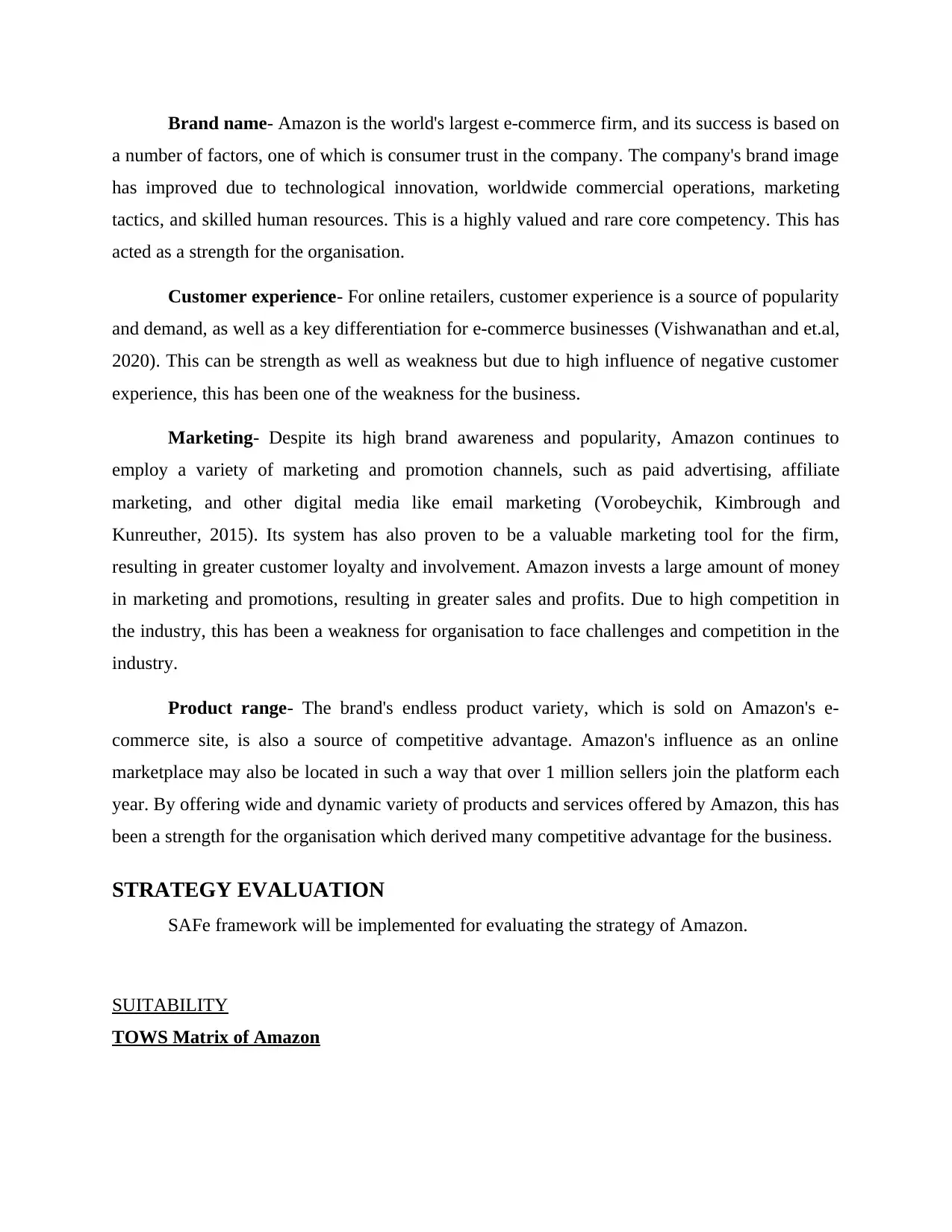
Brand name- Amazon is the world's largest e-commerce firm, and its success is based on
a number of factors, one of which is consumer trust in the company. The company's brand image
has improved due to technological innovation, worldwide commercial operations, marketing
tactics, and skilled human resources. This is a highly valued and rare core competency. This has
acted as a strength for the organisation.
Customer experience- For online retailers, customer experience is a source of popularity
and demand, as well as a key differentiation for e-commerce businesses (Vishwanathan and et.al,
2020). This can be strength as well as weakness but due to high influence of negative customer
experience, this has been one of the weakness for the business.
Marketing- Despite its high brand awareness and popularity, Amazon continues to
employ a variety of marketing and promotion channels, such as paid advertising, affiliate
marketing, and other digital media like email marketing (Vorobeychik, Kimbrough and
Kunreuther, 2015). Its system has also proven to be a valuable marketing tool for the firm,
resulting in greater customer loyalty and involvement. Amazon invests a large amount of money
in marketing and promotions, resulting in greater sales and profits. Due to high competition in
the industry, this has been a weakness for organisation to face challenges and competition in the
industry.
Product range- The brand's endless product variety, which is sold on Amazon's e-
commerce site, is also a source of competitive advantage. Amazon's influence as an online
marketplace may also be located in such a way that over 1 million sellers join the platform each
year. By offering wide and dynamic variety of products and services offered by Amazon, this has
been a strength for the organisation which derived many competitive advantage for the business.
STRATEGY EVALUATION
SAFe framework will be implemented for evaluating the strategy of Amazon.
SUITABILITY
TOWS Matrix of Amazon
a number of factors, one of which is consumer trust in the company. The company's brand image
has improved due to technological innovation, worldwide commercial operations, marketing
tactics, and skilled human resources. This is a highly valued and rare core competency. This has
acted as a strength for the organisation.
Customer experience- For online retailers, customer experience is a source of popularity
and demand, as well as a key differentiation for e-commerce businesses (Vishwanathan and et.al,
2020). This can be strength as well as weakness but due to high influence of negative customer
experience, this has been one of the weakness for the business.
Marketing- Despite its high brand awareness and popularity, Amazon continues to
employ a variety of marketing and promotion channels, such as paid advertising, affiliate
marketing, and other digital media like email marketing (Vorobeychik, Kimbrough and
Kunreuther, 2015). Its system has also proven to be a valuable marketing tool for the firm,
resulting in greater customer loyalty and involvement. Amazon invests a large amount of money
in marketing and promotions, resulting in greater sales and profits. Due to high competition in
the industry, this has been a weakness for organisation to face challenges and competition in the
industry.
Product range- The brand's endless product variety, which is sold on Amazon's e-
commerce site, is also a source of competitive advantage. Amazon's influence as an online
marketplace may also be located in such a way that over 1 million sellers join the platform each
year. By offering wide and dynamic variety of products and services offered by Amazon, this has
been a strength for the organisation which derived many competitive advantage for the business.
STRATEGY EVALUATION
SAFe framework will be implemented for evaluating the strategy of Amazon.
SUITABILITY
TOWS Matrix of Amazon
Paraphrase This Document
Need a fresh take? Get an instant paraphrase of this document with our AI Paraphraser
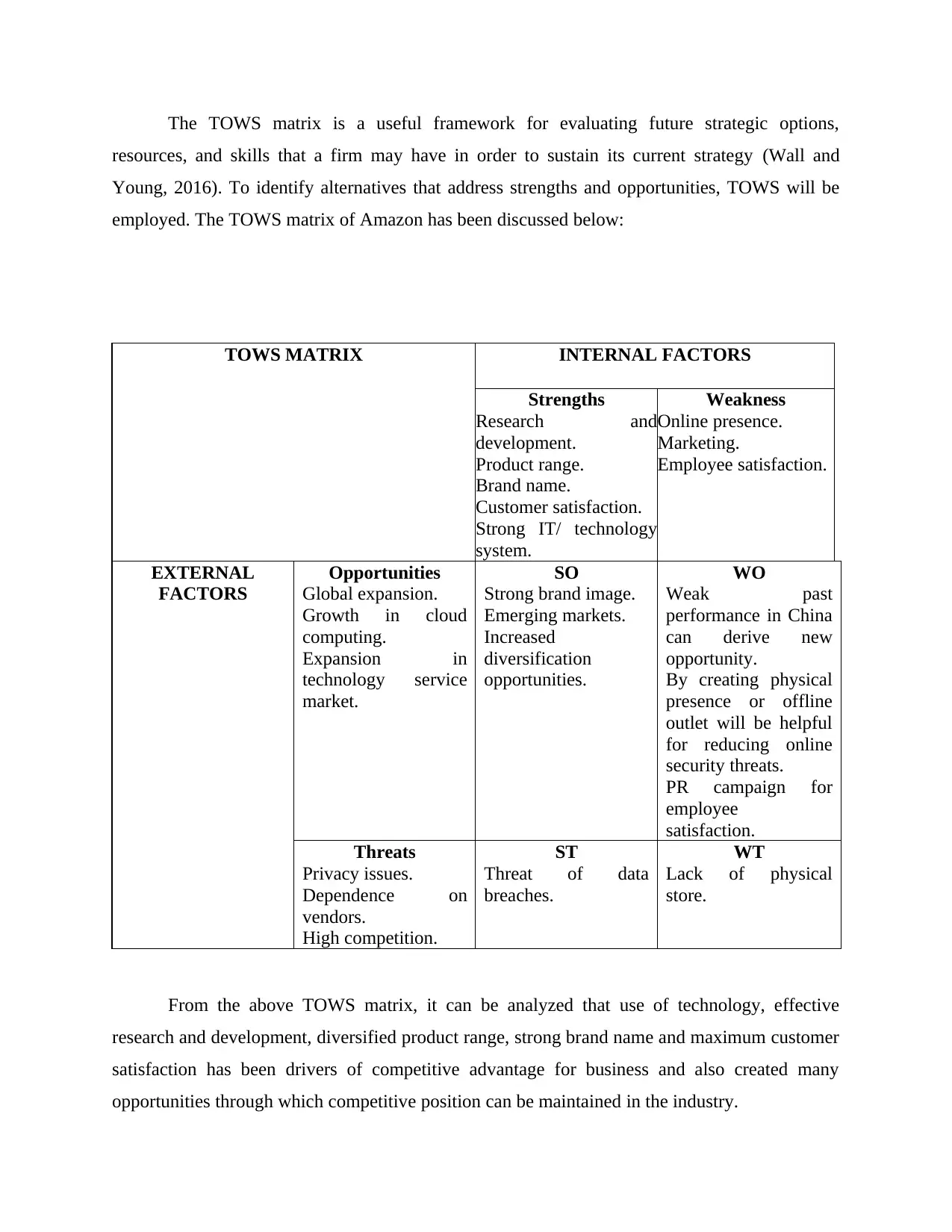
The TOWS matrix is a useful framework for evaluating future strategic options,
resources, and skills that a firm may have in order to sustain its current strategy (Wall and
Young, 2016). To identify alternatives that address strengths and opportunities, TOWS will be
employed. The TOWS matrix of Amazon has been discussed below:
TOWS MATRIX INTERNAL FACTORS
Strengths
Research and
development.
Product range.
Brand name.
Customer satisfaction.
Strong IT/ technology
system.
Weakness
Online presence.
Marketing.
Employee satisfaction.
EXTERNAL
FACTORS
Opportunities
Global expansion.
Growth in cloud
computing.
Expansion in
technology service
market.
SO
Strong brand image.
Emerging markets.
Increased
diversification
opportunities.
WO
Weak past
performance in China
can derive new
opportunity.
By creating physical
presence or offline
outlet will be helpful
for reducing online
security threats.
PR campaign for
employee
satisfaction.
Threats
Privacy issues.
Dependence on
vendors.
High competition.
ST
Threat of data
breaches.
WT
Lack of physical
store.
From the above TOWS matrix, it can be analyzed that use of technology, effective
research and development, diversified product range, strong brand name and maximum customer
satisfaction has been drivers of competitive advantage for business and also created many
opportunities through which competitive position can be maintained in the industry.
resources, and skills that a firm may have in order to sustain its current strategy (Wall and
Young, 2016). To identify alternatives that address strengths and opportunities, TOWS will be
employed. The TOWS matrix of Amazon has been discussed below:
TOWS MATRIX INTERNAL FACTORS
Strengths
Research and
development.
Product range.
Brand name.
Customer satisfaction.
Strong IT/ technology
system.
Weakness
Online presence.
Marketing.
Employee satisfaction.
EXTERNAL
FACTORS
Opportunities
Global expansion.
Growth in cloud
computing.
Expansion in
technology service
market.
SO
Strong brand image.
Emerging markets.
Increased
diversification
opportunities.
WO
Weak past
performance in China
can derive new
opportunity.
By creating physical
presence or offline
outlet will be helpful
for reducing online
security threats.
PR campaign for
employee
satisfaction.
Threats
Privacy issues.
Dependence on
vendors.
High competition.
ST
Threat of data
breaches.
WT
Lack of physical
store.
From the above TOWS matrix, it can be analyzed that use of technology, effective
research and development, diversified product range, strong brand name and maximum customer
satisfaction has been drivers of competitive advantage for business and also created many
opportunities through which competitive position can be maintained in the industry.
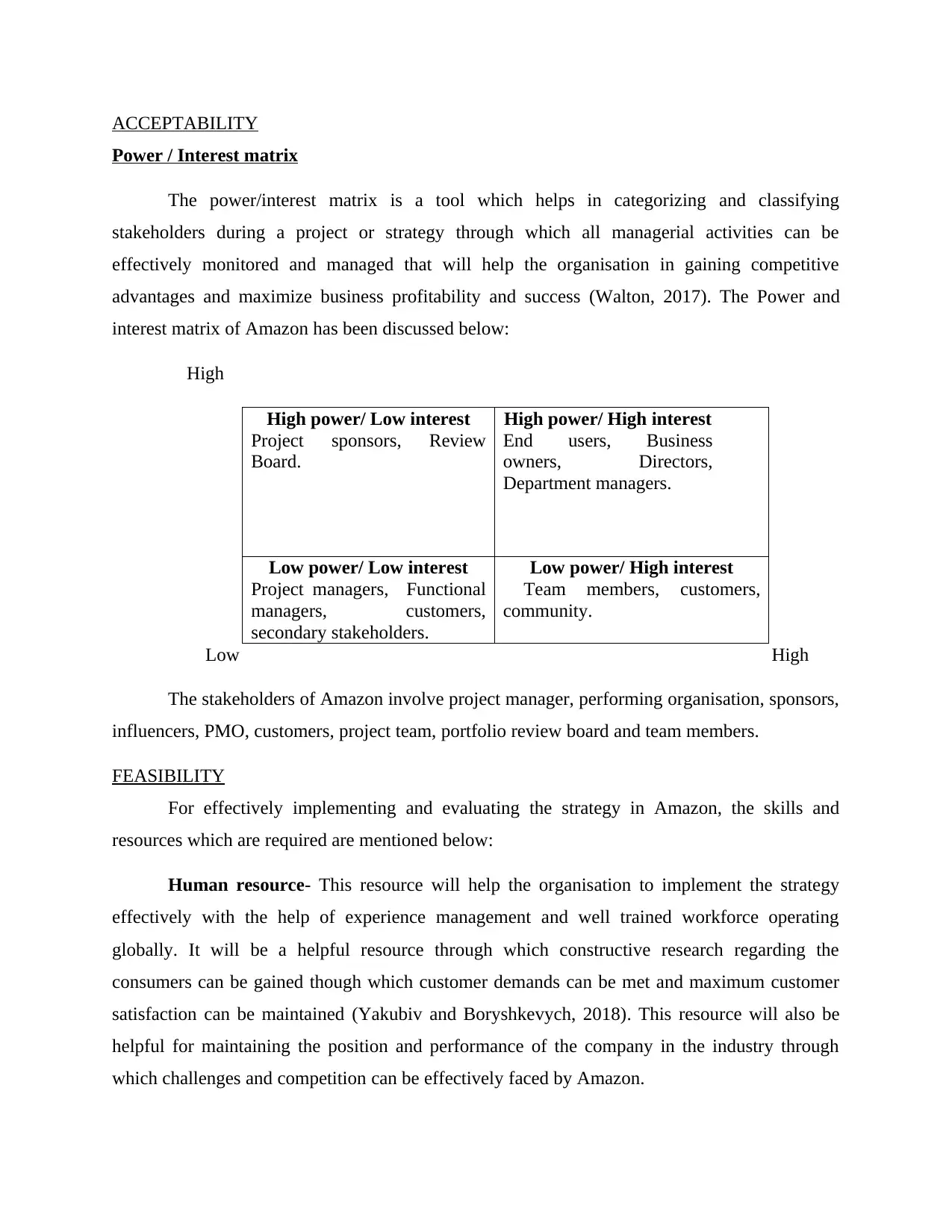
ACCEPTABILITY
Power / Interest matrix
The power/interest matrix is a tool which helps in categorizing and classifying
stakeholders during a project or strategy through which all managerial activities can be
effectively monitored and managed that will help the organisation in gaining competitive
advantages and maximize business profitability and success (Walton, 2017). The Power and
interest matrix of Amazon has been discussed below:
High
High power/ Low interest
Project sponsors, Review
Board.
High power/ High interest
End users, Business
owners, Directors,
Department managers.
Low power/ Low interest
Project managers, Functional
managers, customers,
secondary stakeholders.
Low power/ High interest
Team members, customers,
community.
Low High
The stakeholders of Amazon involve project manager, performing organisation, sponsors,
influencers, PMO, customers, project team, portfolio review board and team members.
FEASIBILITY
For effectively implementing and evaluating the strategy in Amazon, the skills and
resources which are required are mentioned below:
Human resource- This resource will help the organisation to implement the strategy
effectively with the help of experience management and well trained workforce operating
globally. It will be a helpful resource through which constructive research regarding the
consumers can be gained though which customer demands can be met and maximum customer
satisfaction can be maintained (Yakubiv and Boryshkevych, 2018). This resource will also be
helpful for maintaining the position and performance of the company in the industry through
which challenges and competition can be effectively faced by Amazon.
Power / Interest matrix
The power/interest matrix is a tool which helps in categorizing and classifying
stakeholders during a project or strategy through which all managerial activities can be
effectively monitored and managed that will help the organisation in gaining competitive
advantages and maximize business profitability and success (Walton, 2017). The Power and
interest matrix of Amazon has been discussed below:
High
High power/ Low interest
Project sponsors, Review
Board.
High power/ High interest
End users, Business
owners, Directors,
Department managers.
Low power/ Low interest
Project managers, Functional
managers, customers,
secondary stakeholders.
Low power/ High interest
Team members, customers,
community.
Low High
The stakeholders of Amazon involve project manager, performing organisation, sponsors,
influencers, PMO, customers, project team, portfolio review board and team members.
FEASIBILITY
For effectively implementing and evaluating the strategy in Amazon, the skills and
resources which are required are mentioned below:
Human resource- This resource will help the organisation to implement the strategy
effectively with the help of experience management and well trained workforce operating
globally. It will be a helpful resource through which constructive research regarding the
consumers can be gained though which customer demands can be met and maximum customer
satisfaction can be maintained (Yakubiv and Boryshkevych, 2018). This resource will also be
helpful for maintaining the position and performance of the company in the industry through
which challenges and competition can be effectively faced by Amazon.
⊘ This is a preview!⊘
Do you want full access?
Subscribe today to unlock all pages.

Trusted by 1+ million students worldwide
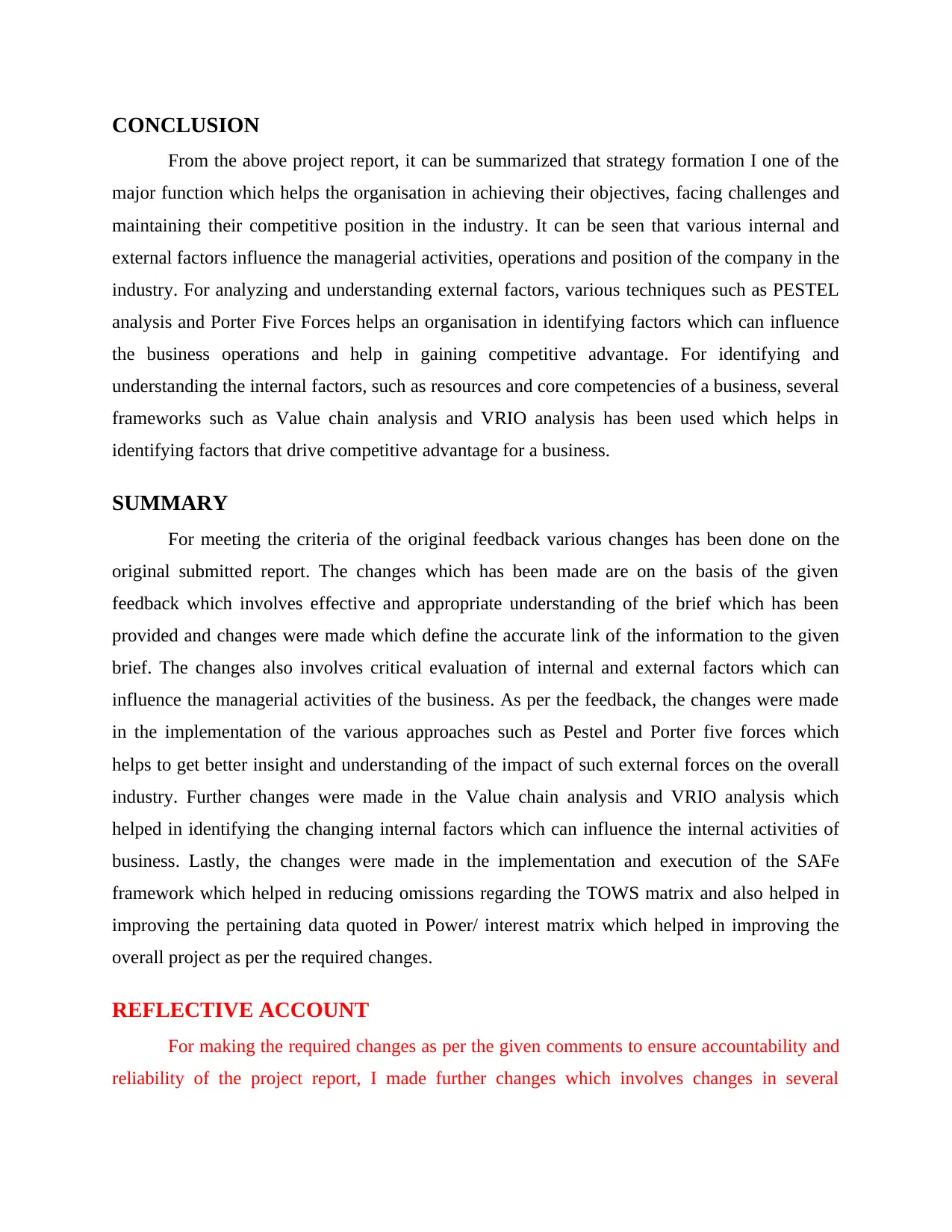
CONCLUSION
From the above project report, it can be summarized that strategy formation I one of the
major function which helps the organisation in achieving their objectives, facing challenges and
maintaining their competitive position in the industry. It can be seen that various internal and
external factors influence the managerial activities, operations and position of the company in the
industry. For analyzing and understanding external factors, various techniques such as PESTEL
analysis and Porter Five Forces helps an organisation in identifying factors which can influence
the business operations and help in gaining competitive advantage. For identifying and
understanding the internal factors, such as resources and core competencies of a business, several
frameworks such as Value chain analysis and VRIO analysis has been used which helps in
identifying factors that drive competitive advantage for a business.
SUMMARY
For meeting the criteria of the original feedback various changes has been done on the
original submitted report. The changes which has been made are on the basis of the given
feedback which involves effective and appropriate understanding of the brief which has been
provided and changes were made which define the accurate link of the information to the given
brief. The changes also involves critical evaluation of internal and external factors which can
influence the managerial activities of the business. As per the feedback, the changes were made
in the implementation of the various approaches such as Pestel and Porter five forces which
helps to get better insight and understanding of the impact of such external forces on the overall
industry. Further changes were made in the Value chain analysis and VRIO analysis which
helped in identifying the changing internal factors which can influence the internal activities of
business. Lastly, the changes were made in the implementation and execution of the SAFe
framework which helped in reducing omissions regarding the TOWS matrix and also helped in
improving the pertaining data quoted in Power/ interest matrix which helped in improving the
overall project as per the required changes.
REFLECTIVE ACCOUNT
For making the required changes as per the given comments to ensure accountability and
reliability of the project report, I made further changes which involves changes in several
From the above project report, it can be summarized that strategy formation I one of the
major function which helps the organisation in achieving their objectives, facing challenges and
maintaining their competitive position in the industry. It can be seen that various internal and
external factors influence the managerial activities, operations and position of the company in the
industry. For analyzing and understanding external factors, various techniques such as PESTEL
analysis and Porter Five Forces helps an organisation in identifying factors which can influence
the business operations and help in gaining competitive advantage. For identifying and
understanding the internal factors, such as resources and core competencies of a business, several
frameworks such as Value chain analysis and VRIO analysis has been used which helps in
identifying factors that drive competitive advantage for a business.
SUMMARY
For meeting the criteria of the original feedback various changes has been done on the
original submitted report. The changes which has been made are on the basis of the given
feedback which involves effective and appropriate understanding of the brief which has been
provided and changes were made which define the accurate link of the information to the given
brief. The changes also involves critical evaluation of internal and external factors which can
influence the managerial activities of the business. As per the feedback, the changes were made
in the implementation of the various approaches such as Pestel and Porter five forces which
helps to get better insight and understanding of the impact of such external forces on the overall
industry. Further changes were made in the Value chain analysis and VRIO analysis which
helped in identifying the changing internal factors which can influence the internal activities of
business. Lastly, the changes were made in the implementation and execution of the SAFe
framework which helped in reducing omissions regarding the TOWS matrix and also helped in
improving the pertaining data quoted in Power/ interest matrix which helped in improving the
overall project as per the required changes.
REFLECTIVE ACCOUNT
For making the required changes as per the given comments to ensure accountability and
reliability of the project report, I made further changes which involves changes in several
Paraphrase This Document
Need a fresh take? Get an instant paraphrase of this document with our AI Paraphraser
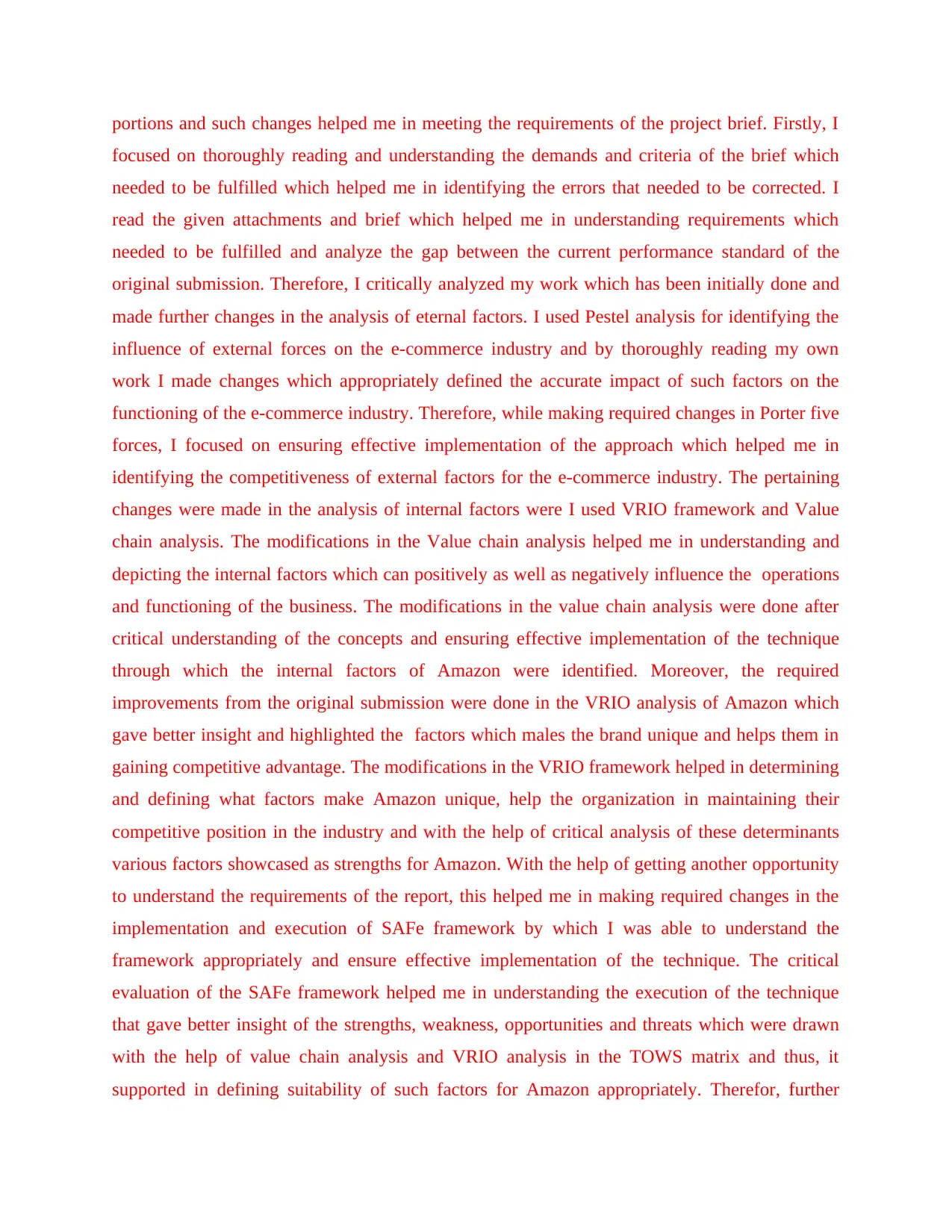
portions and such changes helped me in meeting the requirements of the project brief. Firstly, I
focused on thoroughly reading and understanding the demands and criteria of the brief which
needed to be fulfilled which helped me in identifying the errors that needed to be corrected. I
read the given attachments and brief which helped me in understanding requirements which
needed to be fulfilled and analyze the gap between the current performance standard of the
original submission. Therefore, I critically analyzed my work which has been initially done and
made further changes in the analysis of eternal factors. I used Pestel analysis for identifying the
influence of external forces on the e-commerce industry and by thoroughly reading my own
work I made changes which appropriately defined the accurate impact of such factors on the
functioning of the e-commerce industry. Therefore, while making required changes in Porter five
forces, I focused on ensuring effective implementation of the approach which helped me in
identifying the competitiveness of external factors for the e-commerce industry. The pertaining
changes were made in the analysis of internal factors were I used VRIO framework and Value
chain analysis. The modifications in the Value chain analysis helped me in understanding and
depicting the internal factors which can positively as well as negatively influence the operations
and functioning of the business. The modifications in the value chain analysis were done after
critical understanding of the concepts and ensuring effective implementation of the technique
through which the internal factors of Amazon were identified. Moreover, the required
improvements from the original submission were done in the VRIO analysis of Amazon which
gave better insight and highlighted the factors which males the brand unique and helps them in
gaining competitive advantage. The modifications in the VRIO framework helped in determining
and defining what factors make Amazon unique, help the organization in maintaining their
competitive position in the industry and with the help of critical analysis of these determinants
various factors showcased as strengths for Amazon. With the help of getting another opportunity
to understand the requirements of the report, this helped me in making required changes in the
implementation and execution of SAFe framework by which I was able to understand the
framework appropriately and ensure effective implementation of the technique. The critical
evaluation of the SAFe framework helped me in understanding the execution of the technique
that gave better insight of the strengths, weakness, opportunities and threats which were drawn
with the help of value chain analysis and VRIO analysis in the TOWS matrix and thus, it
supported in defining suitability of such factors for Amazon appropriately. Therefor, further
focused on thoroughly reading and understanding the demands and criteria of the brief which
needed to be fulfilled which helped me in identifying the errors that needed to be corrected. I
read the given attachments and brief which helped me in understanding requirements which
needed to be fulfilled and analyze the gap between the current performance standard of the
original submission. Therefore, I critically analyzed my work which has been initially done and
made further changes in the analysis of eternal factors. I used Pestel analysis for identifying the
influence of external forces on the e-commerce industry and by thoroughly reading my own
work I made changes which appropriately defined the accurate impact of such factors on the
functioning of the e-commerce industry. Therefore, while making required changes in Porter five
forces, I focused on ensuring effective implementation of the approach which helped me in
identifying the competitiveness of external factors for the e-commerce industry. The pertaining
changes were made in the analysis of internal factors were I used VRIO framework and Value
chain analysis. The modifications in the Value chain analysis helped me in understanding and
depicting the internal factors which can positively as well as negatively influence the operations
and functioning of the business. The modifications in the value chain analysis were done after
critical understanding of the concepts and ensuring effective implementation of the technique
through which the internal factors of Amazon were identified. Moreover, the required
improvements from the original submission were done in the VRIO analysis of Amazon which
gave better insight and highlighted the factors which males the brand unique and helps them in
gaining competitive advantage. The modifications in the VRIO framework helped in determining
and defining what factors make Amazon unique, help the organization in maintaining their
competitive position in the industry and with the help of critical analysis of these determinants
various factors showcased as strengths for Amazon. With the help of getting another opportunity
to understand the requirements of the report, this helped me in making required changes in the
implementation and execution of SAFe framework by which I was able to understand the
framework appropriately and ensure effective implementation of the technique. The critical
evaluation of the SAFe framework helped me in understanding the execution of the technique
that gave better insight of the strengths, weakness, opportunities and threats which were drawn
with the help of value chain analysis and VRIO analysis in the TOWS matrix and thus, it
supported in defining suitability of such factors for Amazon appropriately. Therefor, further
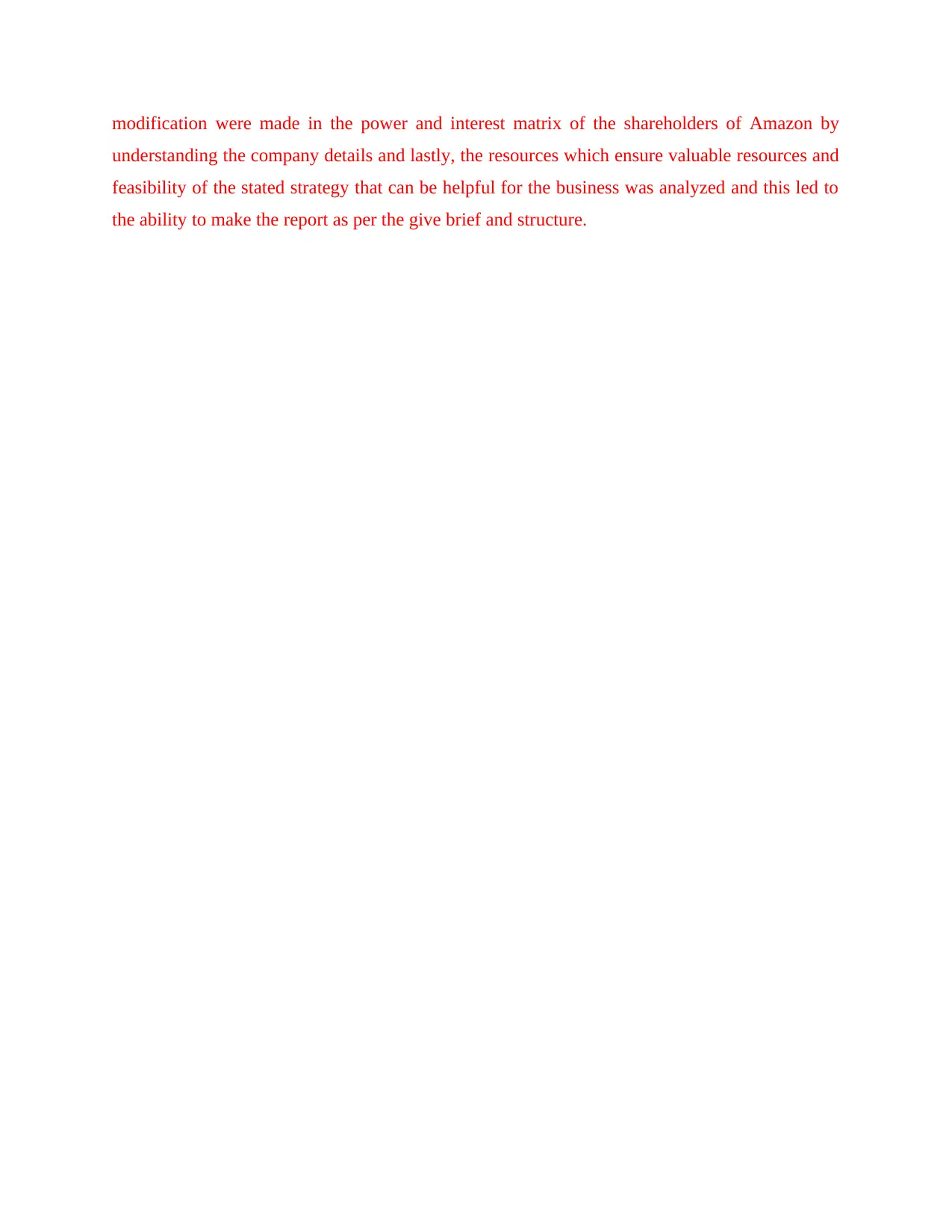
modification were made in the power and interest matrix of the shareholders of Amazon by
understanding the company details and lastly, the resources which ensure valuable resources and
feasibility of the stated strategy that can be helpful for the business was analyzed and this led to
the ability to make the report as per the give brief and structure.
understanding the company details and lastly, the resources which ensure valuable resources and
feasibility of the stated strategy that can be helpful for the business was analyzed and this led to
the ability to make the report as per the give brief and structure.
⊘ This is a preview!⊘
Do you want full access?
Subscribe today to unlock all pages.

Trusted by 1+ million students worldwide
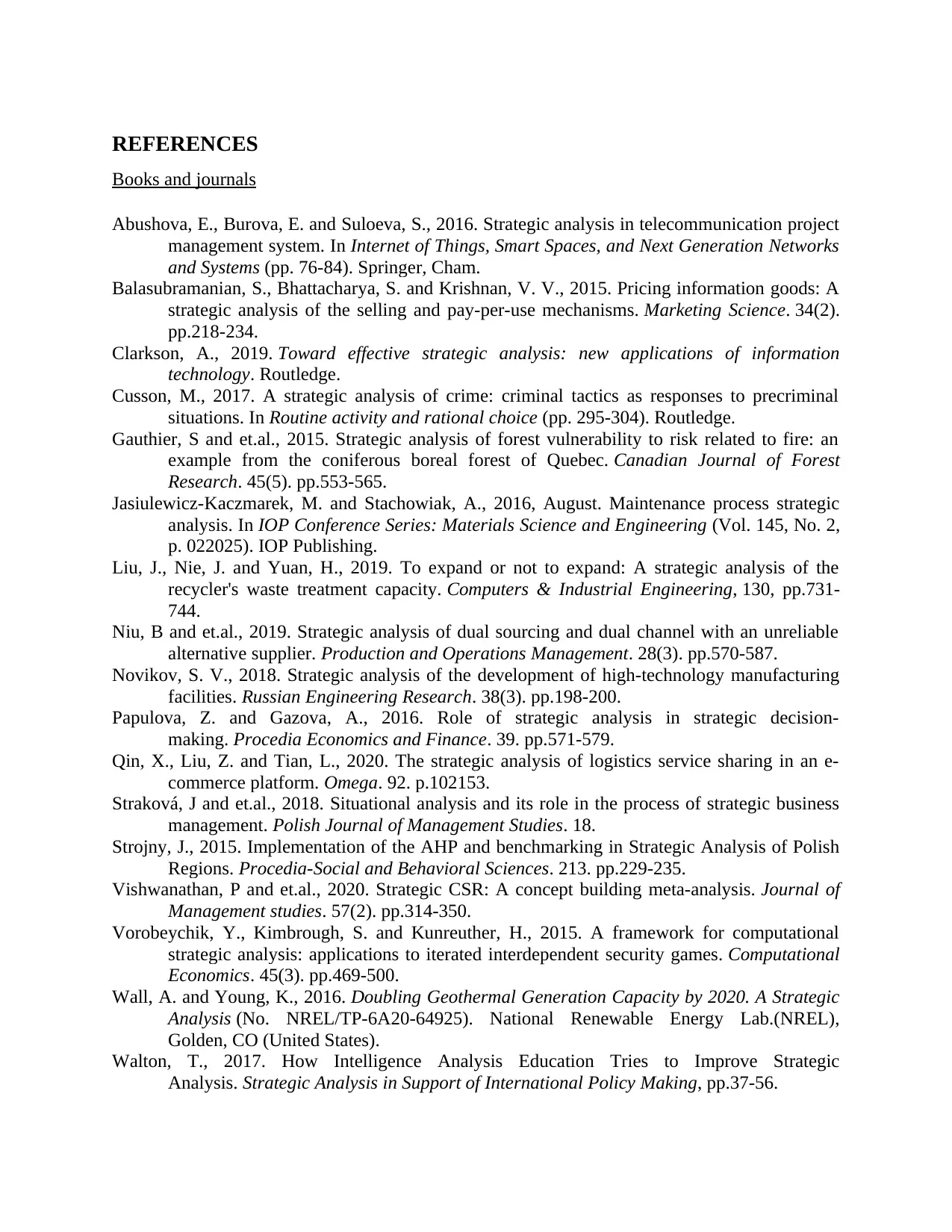
REFERENCES
Books and journals
Abushova, E., Burova, E. and Suloeva, S., 2016. Strategic analysis in telecommunication project
management system. In Internet of Things, Smart Spaces, and Next Generation Networks
and Systems (pp. 76-84). Springer, Cham.
Balasubramanian, S., Bhattacharya, S. and Krishnan, V. V., 2015. Pricing information goods: A
strategic analysis of the selling and pay-per-use mechanisms. Marketing Science. 34(2).
pp.218-234.
Clarkson, A., 2019. Toward effective strategic analysis: new applications of information
technology. Routledge.
Cusson, M., 2017. A strategic analysis of crime: criminal tactics as responses to precriminal
situations. In Routine activity and rational choice (pp. 295-304). Routledge.
Gauthier, S and et.al., 2015. Strategic analysis of forest vulnerability to risk related to fire: an
example from the coniferous boreal forest of Quebec. Canadian Journal of Forest
Research. 45(5). pp.553-565.
Jasiulewicz-Kaczmarek, M. and Stachowiak, A., 2016, August. Maintenance process strategic
analysis. In IOP Conference Series: Materials Science and Engineering (Vol. 145, No. 2,
p. 022025). IOP Publishing.
Liu, J., Nie, J. and Yuan, H., 2019. To expand or not to expand: A strategic analysis of the
recycler's waste treatment capacity. Computers & Industrial Engineering, 130, pp.731-
744.
Niu, B and et.al., 2019. Strategic analysis of dual sourcing and dual channel with an unreliable
alternative supplier. Production and Operations Management. 28(3). pp.570-587.
Novikov, S. V., 2018. Strategic analysis of the development of high-technology manufacturing
facilities. Russian Engineering Research. 38(3). pp.198-200.
Papulova, Z. and Gazova, A., 2016. Role of strategic analysis in strategic decision-
making. Procedia Economics and Finance. 39. pp.571-579.
Qin, X., Liu, Z. and Tian, L., 2020. The strategic analysis of logistics service sharing in an e-
commerce platform. Omega. 92. p.102153.
Straková, J and et.al., 2018. Situational analysis and its role in the process of strategic business
management. Polish Journal of Management Studies. 18.
Strojny, J., 2015. Implementation of the AHP and benchmarking in Strategic Analysis of Polish
Regions. Procedia-Social and Behavioral Sciences. 213. pp.229-235.
Vishwanathan, P and et.al., 2020. Strategic CSR: A concept building meta‐analysis. Journal of
Management studies. 57(2). pp.314-350.
Vorobeychik, Y., Kimbrough, S. and Kunreuther, H., 2015. A framework for computational
strategic analysis: applications to iterated interdependent security games. Computational
Economics. 45(3). pp.469-500.
Wall, A. and Young, K., 2016. Doubling Geothermal Generation Capacity by 2020. A Strategic
Analysis (No. NREL/TP-6A20-64925). National Renewable Energy Lab.(NREL),
Golden, CO (United States).
Walton, T., 2017. How Intelligence Analysis Education Tries to Improve Strategic
Analysis. Strategic Analysis in Support of International Policy Making, pp.37-56.
Books and journals
Abushova, E., Burova, E. and Suloeva, S., 2016. Strategic analysis in telecommunication project
management system. In Internet of Things, Smart Spaces, and Next Generation Networks
and Systems (pp. 76-84). Springer, Cham.
Balasubramanian, S., Bhattacharya, S. and Krishnan, V. V., 2015. Pricing information goods: A
strategic analysis of the selling and pay-per-use mechanisms. Marketing Science. 34(2).
pp.218-234.
Clarkson, A., 2019. Toward effective strategic analysis: new applications of information
technology. Routledge.
Cusson, M., 2017. A strategic analysis of crime: criminal tactics as responses to precriminal
situations. In Routine activity and rational choice (pp. 295-304). Routledge.
Gauthier, S and et.al., 2015. Strategic analysis of forest vulnerability to risk related to fire: an
example from the coniferous boreal forest of Quebec. Canadian Journal of Forest
Research. 45(5). pp.553-565.
Jasiulewicz-Kaczmarek, M. and Stachowiak, A., 2016, August. Maintenance process strategic
analysis. In IOP Conference Series: Materials Science and Engineering (Vol. 145, No. 2,
p. 022025). IOP Publishing.
Liu, J., Nie, J. and Yuan, H., 2019. To expand or not to expand: A strategic analysis of the
recycler's waste treatment capacity. Computers & Industrial Engineering, 130, pp.731-
744.
Niu, B and et.al., 2019. Strategic analysis of dual sourcing and dual channel with an unreliable
alternative supplier. Production and Operations Management. 28(3). pp.570-587.
Novikov, S. V., 2018. Strategic analysis of the development of high-technology manufacturing
facilities. Russian Engineering Research. 38(3). pp.198-200.
Papulova, Z. and Gazova, A., 2016. Role of strategic analysis in strategic decision-
making. Procedia Economics and Finance. 39. pp.571-579.
Qin, X., Liu, Z. and Tian, L., 2020. The strategic analysis of logistics service sharing in an e-
commerce platform. Omega. 92. p.102153.
Straková, J and et.al., 2018. Situational analysis and its role in the process of strategic business
management. Polish Journal of Management Studies. 18.
Strojny, J., 2015. Implementation of the AHP and benchmarking in Strategic Analysis of Polish
Regions. Procedia-Social and Behavioral Sciences. 213. pp.229-235.
Vishwanathan, P and et.al., 2020. Strategic CSR: A concept building meta‐analysis. Journal of
Management studies. 57(2). pp.314-350.
Vorobeychik, Y., Kimbrough, S. and Kunreuther, H., 2015. A framework for computational
strategic analysis: applications to iterated interdependent security games. Computational
Economics. 45(3). pp.469-500.
Wall, A. and Young, K., 2016. Doubling Geothermal Generation Capacity by 2020. A Strategic
Analysis (No. NREL/TP-6A20-64925). National Renewable Energy Lab.(NREL),
Golden, CO (United States).
Walton, T., 2017. How Intelligence Analysis Education Tries to Improve Strategic
Analysis. Strategic Analysis in Support of International Policy Making, pp.37-56.
Paraphrase This Document
Need a fresh take? Get an instant paraphrase of this document with our AI Paraphraser
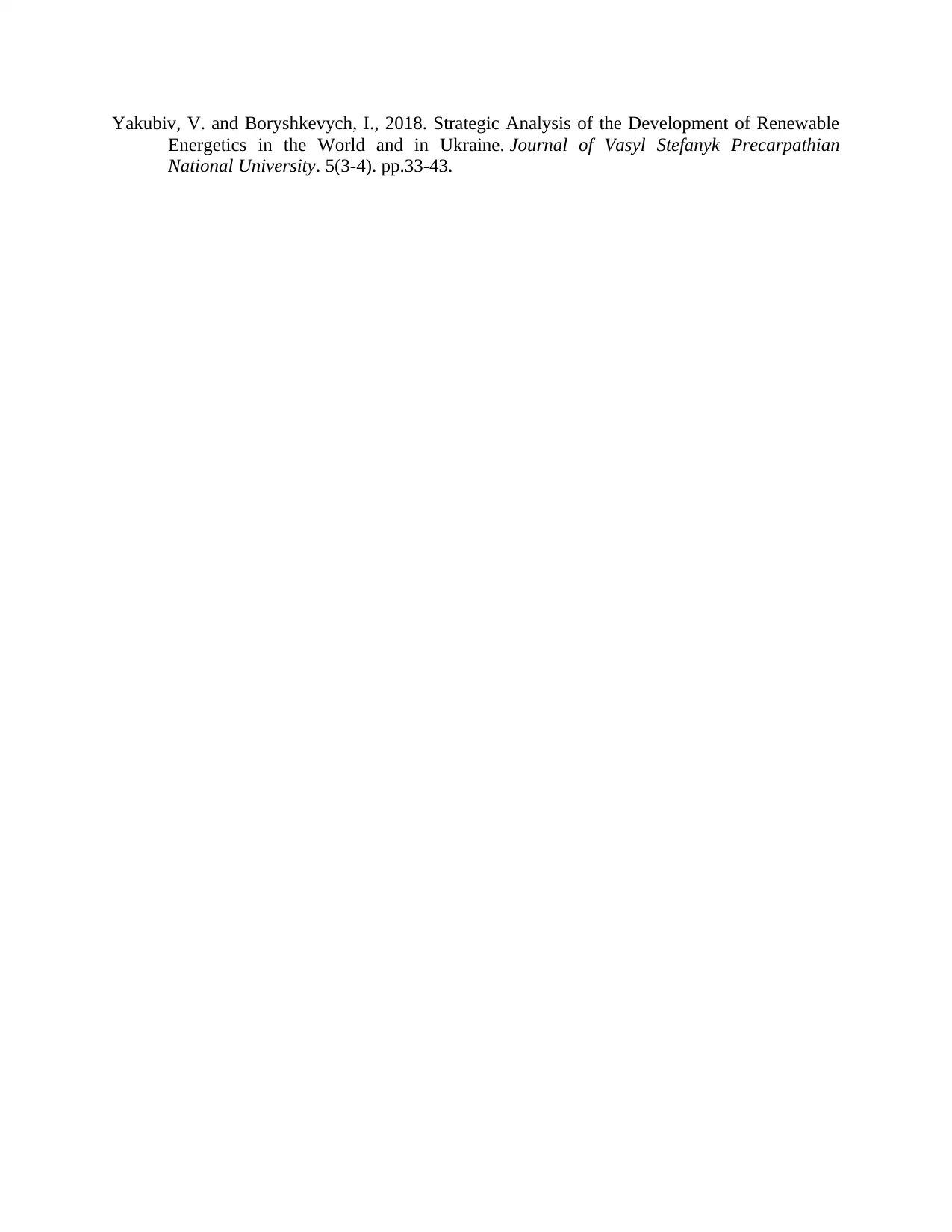
Yakubiv, V. and Boryshkevych, I., 2018. Strategic Analysis of the Development of Renewable
Energetics in the World and in Ukraine. Journal of Vasyl Stefanyk Precarpathian
National University. 5(3-4). pp.33-43.
Energetics in the World and in Ukraine. Journal of Vasyl Stefanyk Precarpathian
National University. 5(3-4). pp.33-43.
1 out of 17
Related Documents
Your All-in-One AI-Powered Toolkit for Academic Success.
+13062052269
info@desklib.com
Available 24*7 on WhatsApp / Email
![[object Object]](/_next/static/media/star-bottom.7253800d.svg)
Unlock your academic potential
© 2024 | Zucol Services PVT LTD | All rights reserved.




